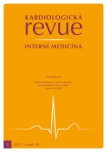Hypertension and ischaemic heart disease – dangerous siblings
Authors:
J. Špác
Authors‘ workplace:
II. interní klinika LF MU a FN Brno
Published in:
Kardiol Rev Int Med 2017, 19(2): 98-101
Overview
Epidemiological studies suggest a strong association between hypertension and ischaemic heart disease (IHD), and hypertension is a major independent risk factor for the development of cardiovascular disease (CVD), including myocardial infarction (MI). Increased blood pressure (BP) also enhances coronary arteriosclerosis, and the combination of myocardial and coronary effects increases the risk of myocardial infarction and arrhythmias. The primary objective of the management of hypertension in patients with IHD is modification of the balance between myocardial oxygen supply and demand to improve the symptoms and reduce future cardiovascular adverse events. This review discusses which antihypertensive drugs should be used in patients who have been diagnosed with IHD with angina pectoris, in those with acute coronary syndromes and MI. Appropriate management should include beta-blockers, angiotensin-converting enzyme inhibitors or angiotensin receptor blockers and calcium channel blockers. In post-acute coronary syndrome (ACS) patients, a J- or U-shaped curve association existed between BP and the risk of future cardiovascular events, which suggests that too low a pressure may be dangerous in patients with a severe form of coronary atherosclerosis.
Keywords:
ischaemic heart disease – hypertension – angina pectoris – acute coronary syndromes – treatment of hypertension
Sources
1. Lewington S, Clarke R, Qizilbash N et al. Prospective Studies Collaboration. Age-specific relevance of usual blood pressure to vascular mortality: a meta-analysis of individual data for one million adults in 61 prospective studies. Lancet 2002; 360(9349): 1903–1913.
2. Yusuf S, Hawken S, Ounpuu S et al. The INTERHEART Investigators. Effect of potentially modifiable risk factors associated with myocardial infarction in 52 countries (the INTERHEART study): case control study. Lancet 2004; 364(9438): 937–952.
3. Davies JE, Whinnett ZI, Francis DP et al. Evidence of a dominant backward-propagating “suction” wave responsible for diastolic coronary filling in humans, attenuated in left ventricular hypertrophy. Circulation 2006; 113(14): 1768–1778.
4. Chobanian AV, Bakris GL, Black HR et al. The seventh report of the joint national committee on prevention, detection, evaluation, and treatment of high blood pressure: the JNC 7 Report. JAMA 2003; 289(19): 2560–2572.
5. Rosendorf C. Treatment of hypertension in patients with coronary artery disease. a case-based summary of the 2015 AHA/ACC/ASH Scientific Statement. Am J Med 2015; 129(4): 372–378. doi: 10.1016/j.amjmed.2015.10.045.
6. Chrysant SG, Chrysant GS. Effectiveness of lowering blood pressure to prevent stroke versus to prevent coronary events. Am J Cardiol 2010; 106(6): 825–829. doi: 10.1016/j.amjcard.2010.05.006.
7. Sipahi I, Tuzcu EM, Schoenhagen P et al. Effects of normal, prehypertensive, and hypertensive blood pressure levels on progression of coronary atherosclerosis. J Am Coll Cardiol 2006; 48(4): 833–838.
8. Wright JT Jr, Williamson JD, Whelton PK et al. The SPRINT Research Group. A randomized trial of intensive versus standard blood-pressure control. N Engl J Med 2015; 373(22): 2103–2116. doi: 10.1056/NEJMoa1511939.
9. Widimský P, Kala P, Rokyta R. Souhrn Doporučených postupů ESC pro diagnostiku a léčbu pacientů s akutním infarktem myokardu s elevacemi úseků ST z roku 2012. Cor Vasa 2012; 54(9–10): 447–463.
10. Hansson L, Zanchetti A, Carruthers SG et al. Effect of intensive blood pressure lowering and low dose aspirin in patients with hypertension: principal results of the Hypertension Optimal Treatment (HOT) randomized trial. Lancet 1998; 351(9118): 1755–1762.
11. Sever PS, Dahlöf B, Poulter NR et al. The ASCOT Investigators. Prevention of coronary and stroke events with atorvastatin in hypertensive patients who have average or lower -than average cholesterol concentrations, in the Anglo-Scandinavian Cardiac Outcomes Trial-Lipid Lowering Arm (ASCOT-LLA): a multicentre randomised controlled trial. Lancet 2003; 361(9364): 1148–1158. doi: 10.1016/S0140-6736(03)12948-0.
12. Willich SN, Müller-Nordhorn J, Kulig M et al. Cardiac risk factors, medication, and recurrent clinical events after acute coronary disease: a prospective cohort study. Eur Heart J 2001; 22(4): 307–313.
13. Thune JJ, Signorovitch J, Kober L et al. Effect of antecedent hypertension and follow-up blood pressure on outcomes after high-risk myocardial infarction. Hypertension 2008; 51(1): 48–54.
14. Abrignani MG, Dominguez LJ, Biondo G et al. In-hospital complications of acute myocardial infarction in hypertensive subjects. Am J Hypertens 2005; 18(2 Pt 1): 165–170.
15. Bangalore SJ, Qin S, Sloan SA et al. What is the optimal blood pressure in patients after acute coronary syndromes?: relationship of blood pressure and cardiovascular events in the pravastatin or atorvastatin evaluation and infection therapy-thrombolysis in myocardial infarction (PROVE IT-TIMI) 22 trial. Circulation 2010; 122(21): 2142–2151. doi: 10.1161/CIRCULATIONAHA.109.905687.
16. Lingman M, Herlitz J, Bergfeldt L et al. Acute coronary syndromes – the prognostic impact of hypertension, diabetes and its combination on long-term outcome. Int J Cardiol 2009; 137(1): 29–36. doi: 10.1016/j.ijcard.2008.05.055.
17. Er F, Dahlem KM, Nia AM et al. Randomized control of sympathetic drive with continuous intravenous esmolol in patients with acute st-segment elevation myocardial infarction. JACC Cardiovasc Interv 2016; 9(3): 231–240. doi: 10.1016/j.jcin.2015.10.035.
Labels
Paediatric cardiology Internal medicine Cardiac surgery CardiologyArticle was published in
Cardiology Review

2017 Issue 2
Most read in this issue
- Target blood pressure values in heart failure
- New fixed antihypertensive combinations
- Electrocardiogram and cardiac stimulation
- Pharmacotherapy of heart failure with preserved ejection fraction
